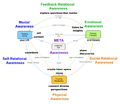Cognitive model
Jump to navigation
Jump to search
A cognitive model is an approximation to animal cognitive processes (predominantly human) for the purposes of comprehension and prediction. Cognitive models can be developed within or without a cognitive architecture, though the two are not always easily distinguishable.
History
[edit]Earlier diagrams
[edit]-
Diagram of the Relation of Human and Cosmic Phenomena. 9th century
-
Diagram illustrating the relationship of the Planets to the Brain, 1159-75
-
Head, showing cells of brain ventricles, c. 1347
-
Circles on either side of the head illustrate the four supposed ventricles of the brain, 14th c.
-
The brain, and ways of excretion of humours, c. 1428
-
The Ventricles, from 1489 to 1503
-
Diagram showing the Ventricles of the Brain, 1496
16th century
[edit]-
nl:Jan van Doesborch (1470/80–1536)
-
Study of the skull metallic point paper by Leonardo da Vinci, 1510
-
Margarita philosophica nova cui insunt sequentia by Gregor Reisch, 1512
-
Congestorium artificiose by Johann Romberch, 1533
-
Andreas Vesalius' famous De humani corporis fabrica libri septem, published in 1543
17th century
[edit]-
Robert Fludd (1574 – 1637)
-
René Descartes (1596-1650)
-
René Descartes (1596-1650)
-
Diagram of ventricles of brain by Descartes
18th century
[edit]-
"Astonishment" from Le Brun, ca 1720
-
"Fear" from Le Brun, Characters des passions, circa 1720.
-
"Horror" from Le Brun, ca. 1720
-
"Sadness" from Le Brun, Characters des passions, circa 1720.
-
Characters and Caricaturas by William Hogarth, 1743
19th century
[edit]- Phrenology
-
Explanation of the new physiognomical system of the brain, 1818
-
Symbolical head, After O.S. Fowler, c.1845
-
Gustav Scheve, Phrenologische Bilder, 1852-55
-
Phrenological organs, 1887
- Other works
-
Ernst Mach's Antimetaphysische Vorbemerkungen, 1886
20th century
[edit]- Philosophy of mind diagrams
-
Turing Test, proposed by Alan Turing, 1936
-
Type physicalism, proposed by John Smart and Ullin Place in the 1950s
-
Multiple realizability, proposed by Hilary Putnam in the 1960s
-
Brain in a vat, proposed by Hilary Putnam (1981)
-
Cartesian theater, proposed by Daniel Dennett (1990)
- Diagrams of cognitive models
-
Filter Model by Donald Broadbent, 1958-2012
-
Baddeley's model of working memory, 1974
-
Baddeley and Hitch's working memory model, 1974
-
The MARS diagram, 1979
-
Baddeley working memory, 1986
-
Graphical representation of Flower & Hayes' 1981 model of the cognitive processes involved in writing
-
PRS Agent Architecture based on diagram from Georgeff and Ingrand, 1989;
-
Model of human information processing after Sanders and McCormick, 1991
21st century
[edit]- Philosophy of mind, diagrams
-
Neural Correlates of Consciousness, Christof Koch (2004)
-
Eight types of consciousness, 2016
- Diagrams of cognitive models
-
Categories in the cognitive domain of the revised Bloom's taxonomy (Anderson et al. 2000)
-
Fundamental structure of a 4D/RCS control loop, 2002.
-
4D-RCS Five levels of the architecture for Demo III, 2002
-
Cognitive Theory of Multimedia Learning, (Mayer, 2005)
-
Left and Right Brain, (Webber, 2007)
-
Cognitive Thought Model (Instructional Design), 2009
-
IDA Cognitive Architecture, (Graeme E. Smith 2009)
-
Schematic memory, 2009
-
abstract and symbolic representation of the term "Bewusstseinsoekologie", 2010
-
Modal model of the mind, 2010
-
Different forms of Awareness, (Carlo Monsanto, 2011)
-
Memory functions, (Bernhard Wenzl, 2011)
-
ADDIE Model of Design, 2012
- Illustrations of the mind
-
2010
-
2011
-
2013
-
2015






















































